Geometrical Representation of Arithmetic Series
Overview
Although the occurrence of "series-area" in this context is quite unusual, there is some evidence in Sanskrit arithmetic texts from medieval India that arithmetic series were represented geometrically at least from the time of Śrīdhara in the 9th or 10th centuries until the time of Nārāyaṇa Paṇḍita in the 14th century. We use old and new translations of these texts to introduce you and your students to geometric problems involving arithmetic series.
Geometrical Representation of Arithmetic Series – Introduction

Figure 1. Teacup (Edited from original photo by Md Amir Mondal, with permission.)
What does the area of the projection of the teacup in Figure 1 have to do with an arithmetic progression? At first sight, probably nothing. Our aim here is to explain the apparently dubious connection between the teacup and the sum of an arithmetic progression.
Areas and volumes of geometric figures have interested people for a long time, both in the sense of explicit calculations which might have practical implications ("how much grain can be stored in a given container?") and in obtaining mathematical expressions which might satisfy an intellectual curiosity ("under what conditions can one find the area of an arbitrary quadrilateral?").
We also find evidence of a lot of interest in series of numbers following a certain pattern in people of different civilizations as early as 1500 BCE. Such series sometimes occurred in the context of practical problems (prices, wages, etc.) and sometimes purely as abstract mathematical objects (say, the sum of first \(n\) natural numbers).
However, representations of series as areas of geometric figures do not occur all that often. Here we will concentrate on this aspect and follow in particular two lesser known Sanskrit texts of arithmetic, the Pāṭīgaṇita of Śrīdhara, written between the 8th and 10th centuries, and the Gaṇitakaumudī, written by Nārāyaṇa Paṇḍita in 1356.
Other than the obvious mathematical interest of this theme, the setting will often give us glimpses of other times and worlds about which we might like to know more.

Figure 2. Bangles for sale in an Indian market (Edited from original photo by Md Amir Mondal, with permission.)
For example, we find in the Pāṭīgaṇita (v. 110) a problem of arithmetic series in which the price of the first and last bangles and their total number are given and one is asked the price of all the bangles. In Figure 2, the bangle at the far right side of the photograph is the smallest one on the wrist and the prices go up linearly with the size.

Figure 3. Portrait of King Prithvi Narayan Shahdev of Nepal (d. 1775) from the private collection of direct descendent Dr. Kunwar Sumerendra Vir Singh Chauhan (Wikimedia Commons, public domain). Interestingly, this image is also identified as a painting of King Gopala, who ruled from 750 to 770 CE and founded the Pala Dynasty of Bengal, at the website, "Yadav History: Great Yadavas: West Bengal" (Google Images).
Then there are kings who decide to move with a constant increase of \(\pi\) (as an approximation, of course!) units per day (Līlāvatī of Bhāskara II),

Figure 4. Painting titled “Śiva cheats Pārvatī” in a game of dice. (Basohli School Painting, Courtesy http://www.exoticindiaart.com/product/paintings/shiva-cheats-parvati-in-game-of-dice-HB67)
and gamblers whose stake-money is in arithmetic progression (Pāṭīgaṇita, v. 112-115). In the exercises we will deal with a few such examples.
Geometrical Representation of Arithmetic Series – Terminology and Trapezia
The systematic study of series, śreḍhī-vyavahāra (literally "series-practices") in Sanskrit, forms part of texts of arithmetic and mensuration called pāṭīgaṇita. Here we will consider finite arithmetic progressions where the difference between two consecutive entries is always the same.
To explain the historical descriptions, we will use modern notations when necessary. We note that the original texts contain no mathematical symbols and descriptions are given entirely in words. Thus the sum of a series is described as follows (Pāṭīgaṇita, v. 85.1):
The common difference multiplied by one-half of the number of terms minus one, increased by the first term, then multiplied by the number of terms, gives the sum of the series.
The Sanskrit terms used here are ādi for the first term, caya for the common difference, pada for the number of terms, and gaṇita for the sum. Rewritten in terms familiar to us: a generic arithmetic series containing \(n\) terms, beginning with a first term \(a\) and increasing by a common difference \(d,\) has the sum \(S_n,\) given by \[S_n=\left(\left(\frac{n-1}{2}\right)\,d +a\right)n.\] We now recognize the familiar result!
Associated to a series \(S,\) we will describe a geometric figure whose total area equals \(S_n\) and whose partial areas equal the partial sums of the series (the units are neglected, since an area and a sum have necessarily different units). Such a figure is known as śreḍhī-kṣetra, which literally means “series-area.” Notice the following comparison, which brings to mind our teacup (Pāṭīgaṇita, v. 79):
As for an earthen pot [śarāva in Sanskrit], the width of the base is smaller and the top larger, so is it for a series-area.
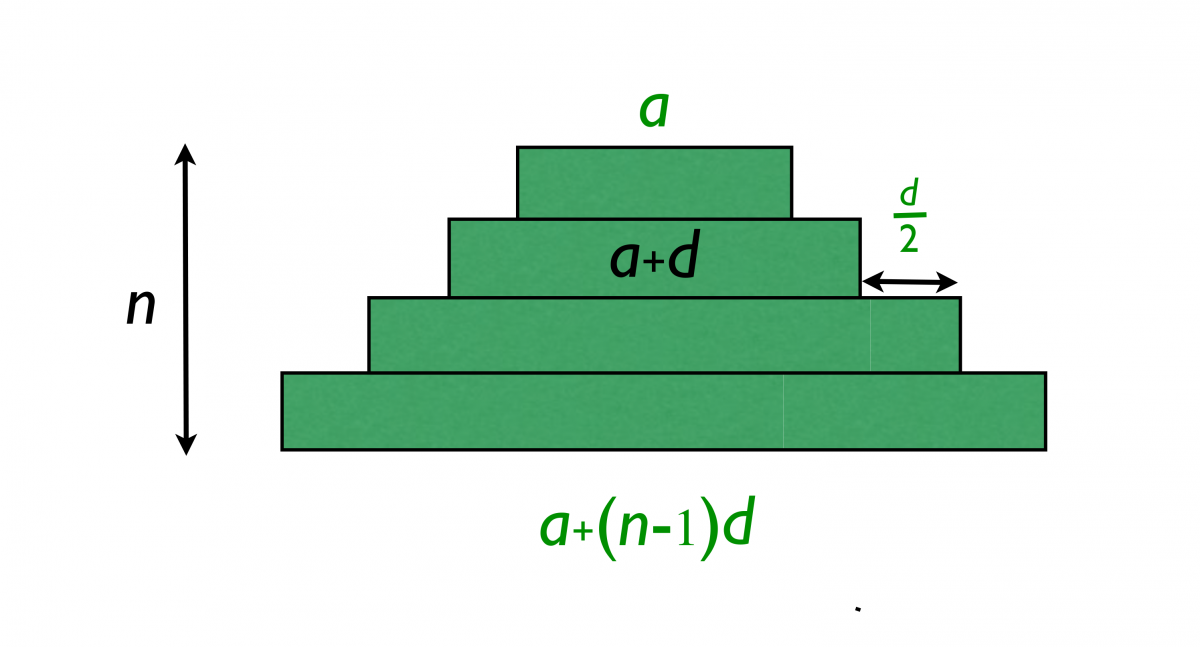
Figure 5. Geometric figure representing the sum of an arithmetic progression, or “series-area”
If we geometrically represent each term of the series by a rectangle with the same length as that term and with breadth 1, then the sum of the areas of the pile of rectangles would give the sum of the series. The representation in Figure 5 looks more like the front view of a staircase than a regular geometric figure.
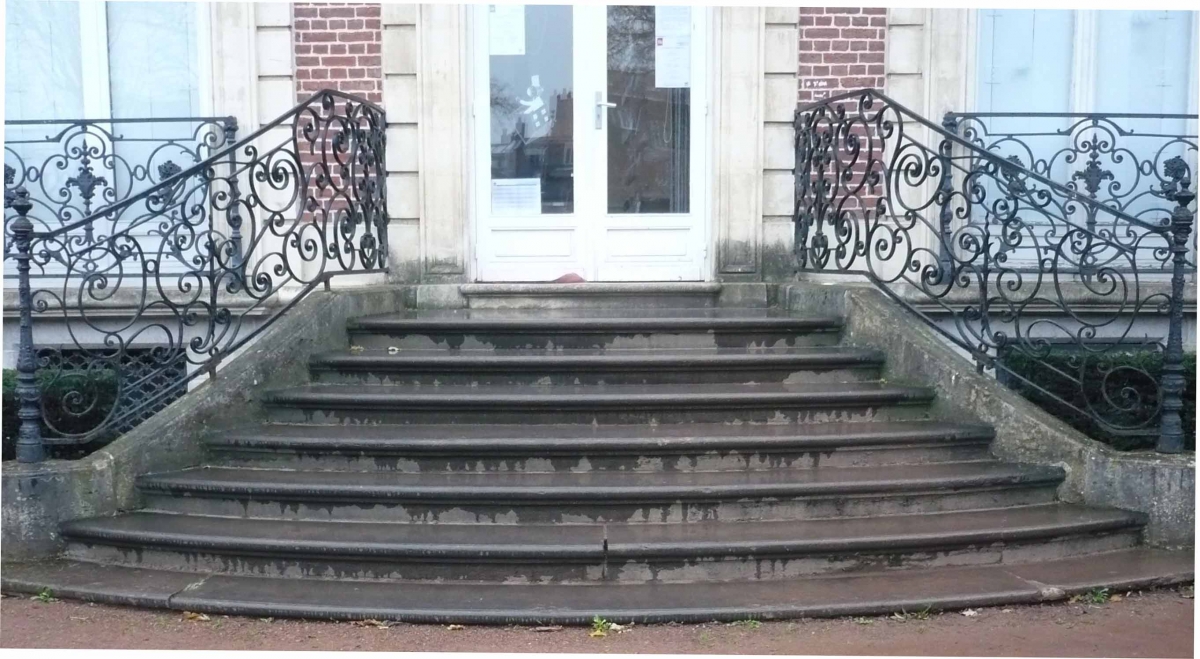
Figure 6. Staircase in Lille, France
But what happens when we rearrange the rectangles a little? Imagine inverting the figure (so it looks more like an earthen pot or teacup) and smoothing it by drawing a line to remove the protruding parts (green) of the rectangles on the right and pasting these “extra” triangles on the other side (red), as shown in Figure 7. Now we get a trapezium with the same area as that of the staircase.

Figure 7. “Staircase” shape inverted and smoothed into a trapezium

Figure 8. Trapezium with area equal to the sum of the arithmetic progression
Furthermore, each term of the series, beginning with the first, is represented as the area of a trapezium. The following text describes this correspondence for the simplest case, i.e. when there is one term (Pāṭīgaṇita, v. 81).
The number of terms which is one is the altitude [lamba] of the series-figure, the first term of the series diminished by half the common difference of the series is the base [dharā], and [the base] increased by the common difference is the face [vaktra].
Let \(b,\) \(f,\) and \(h\) be the base (lower edge in Figure 8), face (top edge in Figure 8), and altitude (or height) of the figure. Then \(b=a-\frac{d}{2}\) and \(f=b+d=a-\frac{d}{2}+d\) for \(h=n=1.\) This is precisely what we have obtained and the trapezium obtained does resemble a two-dimensional teacup!
We emphasize the fact that these descriptions were written in verse with strict metrical rules (lost in translation, alas!) meant to be learnt by heart. Thus they are cryptic and more “rules” than “proofs.” The reader must convince himself that these rules are indeed valid.
For instance the rearrangement we described above (which is a reconstruction of how the ancients might have argued) can be symbolically written as
| \(S_n\) | \(= a+(a+d)+\cdots +(a+(n-1)d)\) |
|
\(={\left(a-\frac{d}{2}\right)}+{\frac{d}{2}}+{\left(a+d-\frac{d}{2}\right)}+{\frac{d}{2}}+\cdots+{\left(a+(n-1)d-\frac{d}{2}\right)} +{\frac{d}{2}}.\) |
To each term of a given series is associated a rectangle (in blue) with height 1 and two triangles (in red) the sum of whose areas is the corresponding term of the series. To obtain the area of the series-figure we use the following simple fact (Pāṭīgaṇita, v. 85.2):
The area [phala] of the [corresponding] series-figure is equal to the product of half of the sum of the base and face, and the altitude.
This is the familiar formula for the area of a trapezium. Thus, when the base is \(a-\frac{d}{2},\) the face \(a-\frac d{2}+nd,\) and the altitude \(n,\) we get the area \[\frac 1 {2}\left(a-\frac d{2}+a-\frac d{2}+nd\right)n=\left(a+(n-1)\frac{d}{2}\right) n=S_n.\] The area of each rectangle with its two triangles gives the corresponding term of the series. Thus the lowest rectangle of length \(a-\frac {d}{2}\) and height \(1\) is \(a-\frac{d}{2}.\) The sum of the areas of the two triangles is \(\frac d {2}\) and these two areas add up to give \(a, \) the first term of the series. The area of the trapezium above the lowest one is \(\frac 1{2}(a+\frac d{2}+a+\frac {3d}{2})=a+d,\) the second term of the series, and so on.
Notice that if we used the first term of the series as the base and the \(n\)th term as the face of the trapezium, its area would still give the sum of the \(n\) terms but the previous terms would no longer correspond nicely to its subsections.
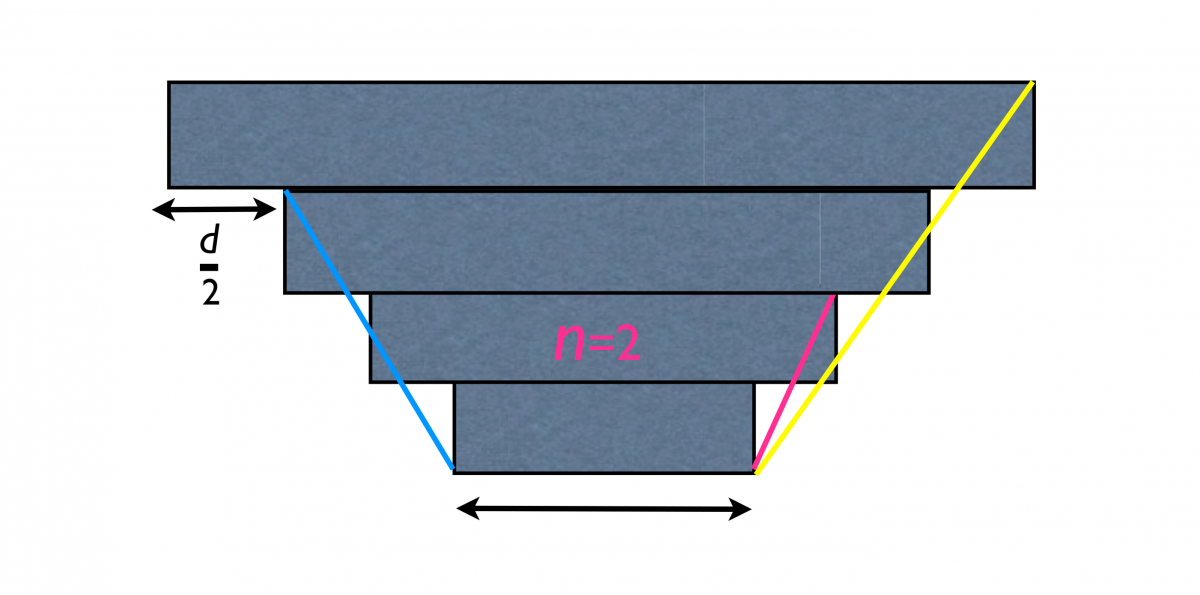
Figure 9. Series-area, or series-figure, with base (of length \(a\)) not reduced
Geometrical Representation of Arithmetic Series – The Twisted Trapezium
In the preceding case, \(a>\frac {d}{2}\) so the base is a positive number. In case \(a<\frac d {2}\) the sum of the series can still be represented as the signed area of a series figure. Note that \(a<\frac {d}{2}\) does not necessarily mean that any of the terms of the series are negative (for example, if \(a=2, d=5\)). In this case we get "negative areas" in the geometric representation until \(a-\frac {d}{2}+kd=0\) where \(k\) need not be an integer. Thus we may have two different areas corresponding to the negative and positive bases of the series-figure, i.e. for the two nearest integers \(k_1\) and \(k_2\) such that \(k_1\le k\le k_2.\)
| \(S_n\) | \(= a+(a+d)+\cdots +(a+(n-1)d)\) |
|
\(=\left(a-\frac d{2}\right)+\frac d{2}+ \left(a+d-\frac d{2}\right)+\frac {d}{2}+\left(a+(n-1)d-\frac d{2}\right)+\frac d {2}\) |
|
| \(={-\left[\left(\frac d{2}-a\right)-\frac d{2}+ \left(\frac d{2}-a-d\right)-\frac {d}{2}+\cdots +\left(\frac d {2}-a-k_1d\right) -\frac {d}{2}+\left(\frac d {2}-a-kd\right) \right]}\) | |
| \(\quad{\ +\left[\left(\frac d {2}-a-kd\right) +\left(a+k_2d-\frac{d}{2}\right)+\frac{d}{2}+\cdots +\left(a+(n-1)d-\frac d{2}\right) +\frac d {2}\right]}.\) |
Since \(a+kd-\frac {d}{2}=0,\) the height of the negative triangle would be \(k=\frac{\frac {d}{2}-a}{d}\) while that of the upper triangle would be \(n-k.\)
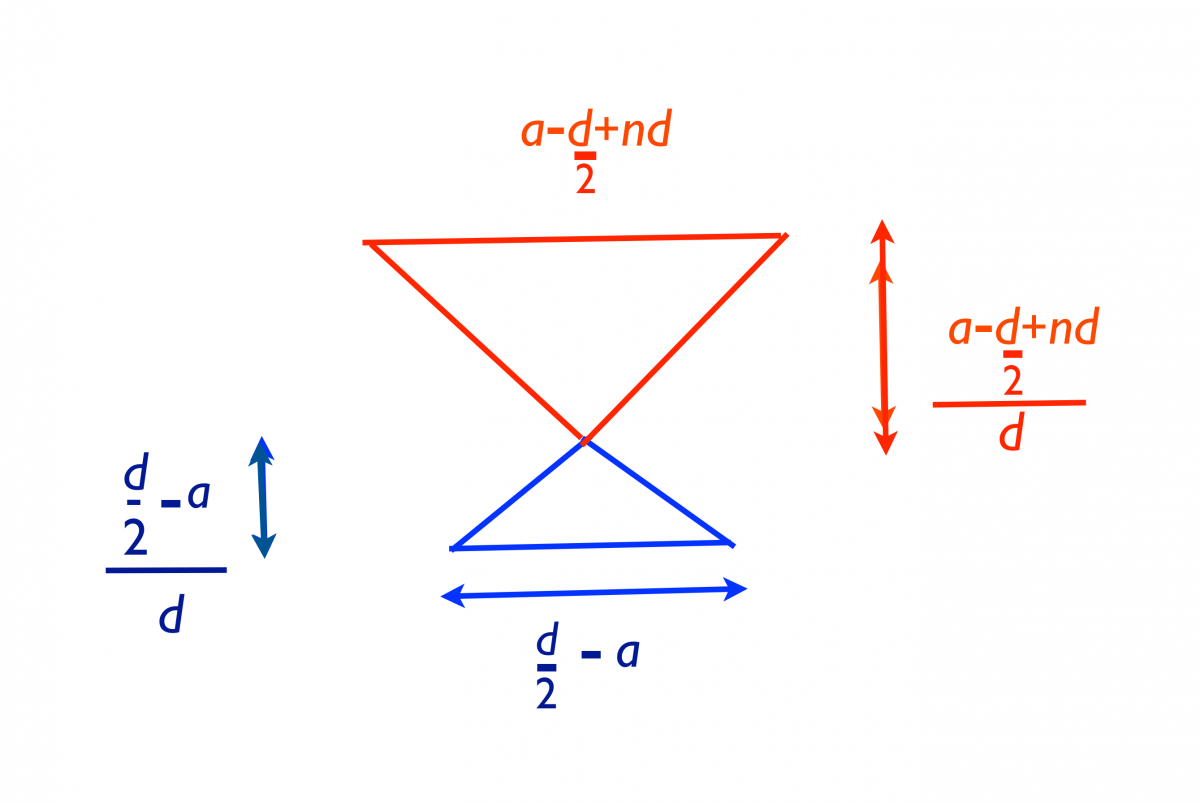
Figure 10. Series-figure with negative base
So in general when the base is negative and the face positive, the figure whose area we are interested in would be that in Figure 10, where the area of the triangle at the bottom is subtracted from that at the top.
This corresponds to what we find in a text, this time with ku for base, vivara for difference, and tryasra for triangle (Gaṇitakaumudī, vol. 2, pp. 86-87):
If the base is negative, however, the two sides will cross each other and grow. There will be two triangles, upper and lower, with the base and the face as the bases. The base and the face divided by the face minus the base and multiplied by the altitude are the altitudes of the two triangles. The difference of their areas is equal to the sum of the series.
For the heights of the lower and upper triangles denoted by \(h_1\) and \(h_2,\) respectively, we get
| \(\frac{b}{f-b}n=\) | \(h_1=\frac{d/2-a}{nd}n\) |
| \(\frac{f}{f-b}=\) | \(h_2=\frac{a-d/2+nd}{nd}n\) |
since \(f-b=\frac {d}{2}-a+nd-(\frac {d}{2}-a)=nd.\) Thus \(h_1\) obtained here is precisely the \(k\) that we had before.
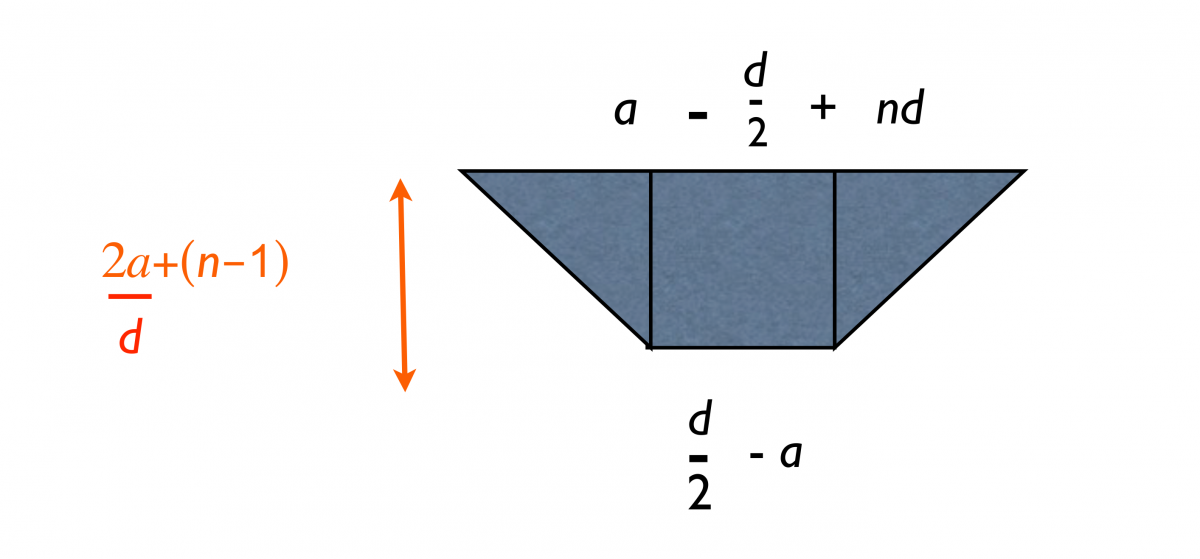
Figure 11. Triangles to trapezium
Notice that this again gives a trapezium with the same face and base, but the distance between the parallel lines is less than the height for the case where the base is positive. If both the base and face are negative the series-figure would be constructed exactly as for the case of positive base and face but the sum would be negative.
Geometrical Representation of Arithmetic Series – In the Classroom
Proposed Lesson Plan
Objectives
- To show a simple yet elegant relation between arithmetic and geometry.
- To read and interpret an historical mathematical text in translation.
- To arouse historical and cultural curiosity.
Required Background
- Secondary school geometry, arithmetic, and algebra.
- Capacity to manipulate simple equations.
Activities
- Brief background of arithmetic in ancient Indian texts (5 minutes).
- Recall basics of arithmetic progression (5 minutes).
- Description of sum of series expressed geometrically (10 minutes). The nuances may be included or not.
- Reading of translated verses (10 minutes).
- Examples with drawings (10-15 minutes).
Assessment: Problems
The following exercises may be given as part of a written assignment or an examination. All but Problems 1 and 3 are from Sanskrit texts as indicated.
- Prove that the formula for the sum of an arithmetic series of \(n\) terms with given first term \(a\) and constant difference \(d\) is correct using modern notation and methods.
- On an expedition to seize his enemy's elephants, a king marched two units the first day. With what increasing rate of daily march did he proceed, if he reached his enemy's city, a distance of eighty units, in a week? (Līlāvatī, v. 124) Draw the associated series figure.
- Draw a series figure to represent the sum of the first 10 positive odd integers. Obtain a general formula by replacing 10 by \(n\) and show that this agrees with the area of the corresponding series-figure.
- (This problem could be considered as an amusing variation of the last.) In a dice game, two people alternately win 4, 3, 2, and 2 casts of dice from each other. The stake-money begins with 1 and increases by 2 with each successive roll. (Pāṭīgaṇita, v. 115) Draw the corresponding series figure (you may use different colors for the opponents) and decide who the winner is.
- One man travels with an initial speed of 3 yojanas per day and acceleration 1 yojana per day. Another man travels with the (constant) speed of 10 yojanas per day. In what time will they cover the same distance? (Pāṭīgaṇita, v. 111) Draw the corresponding series-figures. (The yojana was a measure of distance very roughly between 5 and 15 kilometers (roughly, 3 to 9 miles).)
- If the first term of a series is 3, the common difference 7, and the number of terms \(\frac1{7},\) what is the area of its series figure? (Gaṇitakaumudī, Vol. 2, v. 63) Can you draw a trapezium corresponding to this series?
- Find the area of the series figure where the first term of a series is \(\frac1{2},\) the common difference 3, and the number of terms \(3\frac{1}{3}.\) (Gaṇitakaumudī, Vol 2, v. 62.2) Draw the figure.
- A man gave his son-in-law sixteen units of money the first day; and diminished the sum by two units per day. How many units had he bestowed when the ninth day was past? (Brāhmasphuṭasiddhānta of Brahmagupta, Chapter 12) Draw the series-figure.
- (Challenge problem) What is the number of cows at the end of 20 years, starting with one cow that gives birth to one calf every year and every calf in turn beginning to reproduce at the age of 3 years? (Gaṇitakaumudī, Vol. 1, p. 126)
Cryptic Answers
- A constructive derivation and/or a proof by mathematical induction may be given.
- \(d= \frac{22}{7}.\)
- \(S_{10}=100, S_n=n^2,\) triangle.
- First \(1+3+5+7,\) second \(9+11+13,\) etc.; second player wins; triangle with trapeziums inside.
- \(15\) days, rectangle and trapezium.
- \(A =0,\) upper and lower triangles of equal area.
- \(A=\frac{40}{3},\) base negative, face positive.
- \(S_9=72,\) base positive, face negative.
- \(2745\) if each cow produces her first calf just before or just as she turns 3 years old; \(907\) if each cow produces her first calf only after she turns 3 years old and before she turns 4 years old.
Geometrical Representation of Arithmetic Series – Bibliography, Acknowledgments, About the Author
Bibliography
Brāhmasphuṭasiddhānta of Brahmagupta, R. S. Sharma (ed.). New Delhi: Indian Institute of Astronomical and Sanskrit Research, 1966.
Līlāvatī of Bhāskaracārya, V.A. Apte (ed.), Anandāśrama Sanskrit Series No. 107, Pune, 2007.
Pāṭīgaṇita of Śrīdharacārya, with an ancient Sanskrit commentary, K.S. Shukla (ed.), Lucknow University, 1959.
Gaṇitakaumudī by Nārāyaṇa Paṇḍita, P. Dvivedī (ed.), Sarasvati Bhavana Texts 57, Benares, 1942.
Plofker, Kim, Mathematics in India, Princeton University Press, 2008.
Acknowledgments
This project was supported by an History of Astronomical and Mathematical Sciences in India - Chennai Mathematical Institute (HAMSI-CMI) International Fellowship, History of Mathematics Season, Nov.–Dec. 2014. I am thankful also to Clemency Montelle, Kim Plofker, and Glen Van Brummelen for their inspiration to create teaching material.
About the Author
Gautami Bhowmik is a number theorist at the Université de Lille, France (Laboratoire Painlevé, LABEX-CEMPI, Université Lille 1, 59655 Villeneuve d’Ascq Cedex, France). She spent the 2013-14 academic year at the Laboratoire SPHERE (Sciences, Philosophie, Histoire), UMR 7219, Université Paris 7, on a Centre National de la Recherche Scientifique (CNRS) delegation to work on Sanskrit texts. During November and December of 2014, she participated in the annual "History of Mathematics Season" sponsored by the History of Astronomical and Mathematical Sciences in India (HAMSI) program, carrying out research projects in history of Indian mathematics at the Chennai Mathematical Institute, India, with historians of mathematics Clemency Montelle, Kim Plofker, and Glen Van Brummelen.